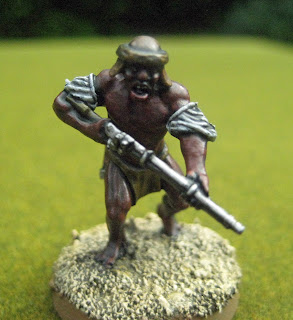Regiments
of the Zulu Army.
The
Mbonambi Ibutho.
Click on any of the photos to get a bigger and better view!
 My
first completed Zulu regiment is my interpretation of the Mbonambi Ibutho, in
1879, an un-married regiment, originally formed in the time of Shaka, but
reformed by King Mpande sometime around 1863 from youths born around 1842. In
his Osprey publication, ‘The Zulu War’, Angus McBride shows a warrior of the
Mbonambi wearing the headring (isicoco), denoting a man of married status, but
I have depicted all my regiment without the headring. The shields are of a
regiment of relatively junior status, being mostly black with a scattering of
white blotches.
My
first completed Zulu regiment is my interpretation of the Mbonambi Ibutho, in
1879, an un-married regiment, originally formed in the time of Shaka, but
reformed by King Mpande sometime around 1863 from youths born around 1842. In
his Osprey publication, ‘The Zulu War’, Angus McBride shows a warrior of the
Mbonambi wearing the headring (isicoco), denoting a man of married status, but
I have depicted all my regiment without the headring. The shields are of a
regiment of relatively junior status, being mostly black with a scattering of
white blotches. When the Sikali ran out of ammunition, the Mbonambi rose and pursued Durnford into the British tent lines. In ‘The Anatomy of the Zulu Army’, Ian Knight suggests that part of the Mbonambi’s head dress may have been granted as a distinction for being the first of the Zulu Impi to breach the British line.


The
Mbonambi also fought at the Battle of Kambula, where, this time, they formed
part of the right horn with the uNokhenke and the umCijo. The Mbonambi attacked
up hill against the main British defensive laager, manned by the 90th
Infantry Regiment, and were driven back, suffering severe casualties. In spite
of having taken part in two major battles, the Mbonambi were in action again at
Gingindlovo, where Somopo hoped to stop Chelmsford and his relief force heading
towards the beleaguered Colonel Pearson at Eshowe.







No comments:
Post a Comment